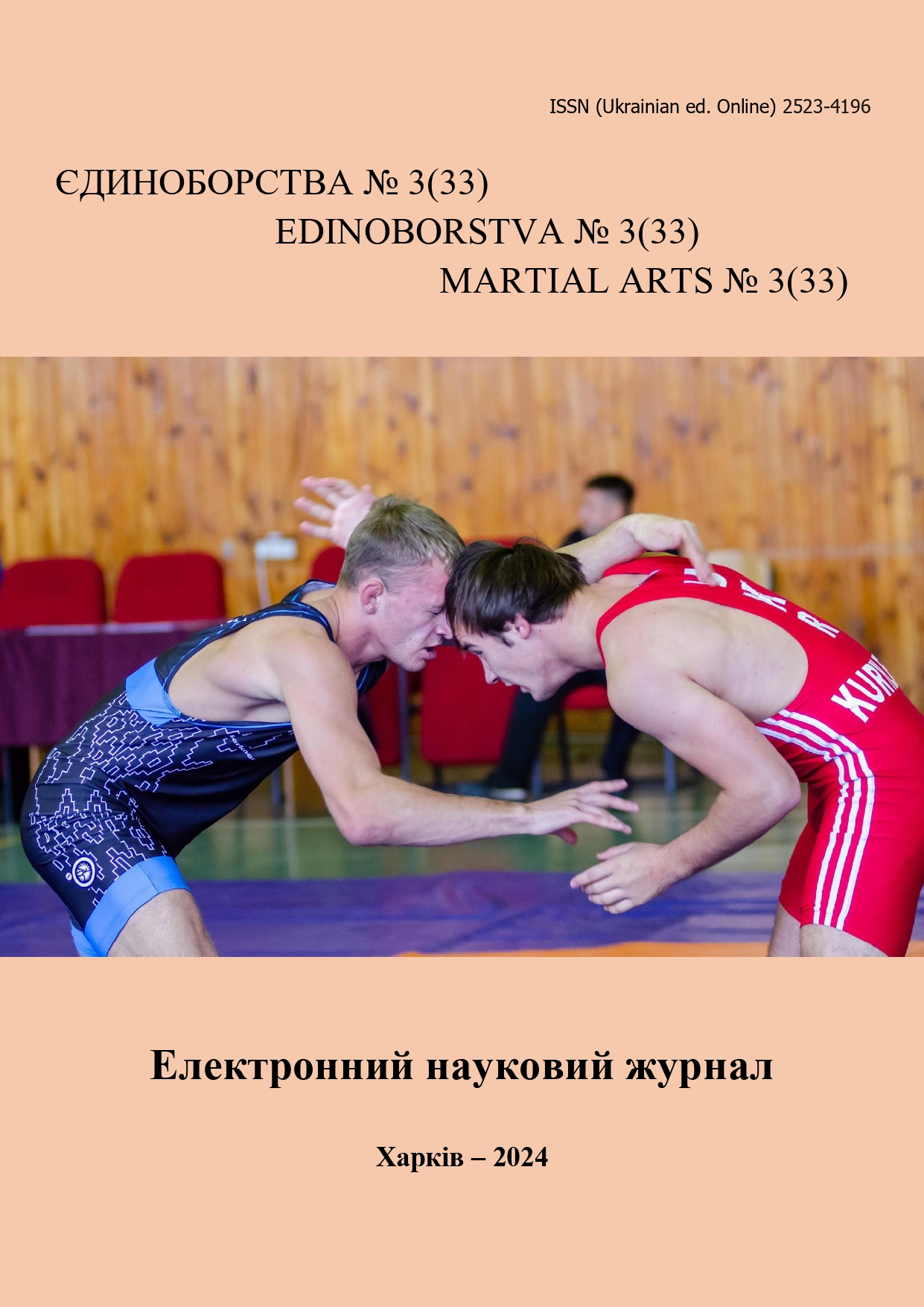Новітні можливості оцінки простої зорово-моторної реакції з використанням сучасних мобільних технологій
DOI:
https://doi.org/10.15391/ed.2024-3.06Ключові слова:
проста реакція, мобільний застосунок, вимірювання, єдиноборства, мобільні пристроїАнотація
Мета: дослідити новітні можливості оцінки простої зорово-моторної реакції з використанням сучасних мобільних технологій. Матеріал та методи. Методи дослідження: аналіз і узагальнення науково-методичної літератури; психофізіологічні вимірювання; математико-статичні методи з використанням ліцензійних програм RStudio та Numbers. Дослідження проведено в декілька етапів. На першому етапі дослідження приймали участь 135 студентів Харківської державної академії фізичної культури та Харківської державної академії культури різних спеціалізацій, віком 18-23 років: єдиноборства (n=45); спортивні ігри (n=28); спортивна, художня гімнастика (n=22); танці, хореографія (n=40). На другому етапі дослідження представлено результати вимірювань понад 200 респондентів, різного віку, різної статті, користувачів застосунку «Reaction Visual & Acoustical» на платформі iOS, ті що надали свої результати в «Game Center». Результати: на першому етапі дослідження згідно результатів вимірювань отримана інформація щодо особливостей прояву простої зорово-моторної реакції студентів різних спеціалізацій. Зазначено, що на рівень прояву реакції впливає рівень спортивної кваліфікації спортсменів. Так, найменші зміни за межами верхнього та нижнього квартилів можна побачити в групі єдиноборців. Саме в цієї групі було більше студентів, які мали вищу спортивну кваліфікацію. Найбільші зміни за межами верхнього та нижнього квартилів спостерігаються в групі спортивних ігор, що свідчить про наявність в цієї групі спортсменів різного рівня кваліфікації. На другому етапі дослідження згідно результатів порівняльного аналізу визначено, що між показниками вимірювань користувачів сервісу «Game Center» та показниками студентів різних спеціалізацій немає статистично значимих відмінностей (p>0,05). Порівняння результатів вимірювань в досліджуваних групах свідчить, що час простої зорово-моторної реакції єдиноборців статистично менше (p<0,05) ніж час реакції представників інших спеціалізацій та користувачів «Game Center». Висновки. Сучасні комп'ютерні технології дозволяють підвищити точність та швидкість отримання результатів різноманітних вимірювань, заощадити час на обробку результатів, оперативно формулювати висновки та приймати відповідні рішення. Результати, які були отримані в ході дослідження свідчать, що на рівень прояву реакції впливає рівень спортивної кваліфікації спортсменів. Так, визначено, що єдиноборці, з вищою спортивною кваліфікацією, які пройшли відповідні етапи відбору мають більш розвинуті психофізіологічні можливості щодо прояву різних видів реакцій. Згідно результатів порівняльного аналізу можна стверджувати, що між показниками вимірювань простої зорово-моторної реакції користувачів сервісу «Game Center» та показниками студентів різних спеціалізацій немає статистично значимих відмінностей (p>0,05).Посилання
Голяка, С.К. (2005). Властивості нейродинамічних та психомоторних функцій у студентів з різним рівнем спортивної майстерності (Автореф. дис. … канд. біол. наук). Херсон, Україна.
Коробейніков, Г.В. (2004). Психофізіологічні властивості спортсменів складнокоординаційних видів спорту. Фізичне виховання і спорт у сучасних умовах, 160–167.
Кулініч, І.В. (2006). Властивості основних нервових процесів у спортсменів різного віку та спортивної спеціалізації. Психофізіологічні та вісцеральні функції в нормі і патології, 71–72 .
Макаренко, М.В., & Лизогуб, В. С. (2015). Реакція на рухомий об’єкт як тест на визначення зрівноваженості нервових процесів. Вісник Національного університету оборони України, 1 (44), 142-147.
Романенко, В., Тропін, Ю., Бойченко, Н., & Голоха, В. (2019). Контроль успішності студентів з використанням комп’ютерних технологій. Слобожанський науково-спортивний вісник, 2(70), 75-79 DOI:10.15391/snsv.2019-2.013
Ashanin, V., & Romanenko, V. (2015). The use of computer technologies at an assessment of sensory-motor reactions in single combats. Slobozhanskyi herald of science and sport, 4(48), 5-7.
Boloban, V. (2019). Sensorimotor coordination as the basis of technical preparation. Science in Olympic Sport, 4, 75-84.
Boring, E.G. (1950). A history of experimental psychology (2nd ed.). New York: Appleton–Century–Crofts.
Ermakov, S., Kozina, Z., Cieslicka М., Musketa, R., Krzeminski М., & Stankevich, B. (2016). Development of computer programs to determine the psychophysiological capabilities and properties of the nervous system of people with different levels of physical activity. Health, Sport, Rehabilitation, 2(1), 14–18. DOI:10.34142/HSR.2016.02.01.05
Galton, F. (1889). Instrument for determining reaction-time. Report of the British Association for the Advancement of Science, 5, 784–785.
Iermakov, S., Podrigalo, L., Romanenko, V., Tropin, Y., Boychenko, N., & Rovnaya, O. (2016). Psycho-physiological features of sportsmen in impact and throwing martial arts. Journal of Physical Education and Sport, 16(2), 433-441. DOI:10.7752/jpes.2016.02067
Irwin W. Silverman (2010). Simple reaction time: It is not what it used to be. The American Journal of Psychology, 123 (1): 39–50. DOI:10.5406/amerjpsyc.123.1.0039
Jensen, A. R. (1980). Bias in mental testing. New York: Free Press.
Johnson, R.C., McClearn, G., Yuen, S., Nagosha, C.T., Abern, F.M., & Cole, R.E. (1985). Galton’s data a century later. American Psychologist, 40, 875–892.
Krieg, E.F., Jr., Chrislip, D.W., Letz, R.E., Otto, D.A., Crespo, C.J., Brightwell, W.S., et al. (2001). Neurobehavioral test performance in the third National Health and Nutrition Examination Survey. Neurotoxicology and Teratology, 23, 569–589.
Robert T. Wilkinson, Sue Allison. (1989). Age and Simple Reaction Time: Decade Differences for 5,325 Subjects, Journal of gerontology, 44.2, 29-35.
Romanenko, V., Piatysotska, S., Tropin, Yu., Rydzik, Ł., Holokha, V., & Boychenko, N. (2022). Study of the reaction of the choice of combat athletes using computer technology. Slobozhanskyi Herald of Science and Sport, 26(4), 97-103. DOI:10.15391/snsv.2022-4.001
Тsyhanovska, N., Veretelnikova, N., Romanenko, V., Batulin, D., Arkhypova, A., & Honchar, V. (2017). Physical and psycho-sensory abilities as the basis of motivation of students to systematic section classes in the system of physical education of HEI. Slobozhanskyi herald of science and sport, № 1(57), 91-94.
Turlisova, & J., Jansone, A. (2021). ViMoT - Development of Visual-Motor Tests Methodology Including the Adoption of Uniform Rules and Digital Test Development. International Journal of Human Movement and Sports Sciences, 9(2): 250-254. DOI:10.13189/saj.2021.090213
Wilkinson, R. T., & Allison, S. (1989). Age and simple reaction time: Decade differences for 5,324 subjects. Journal of Gerontology, 44, 29–35.













